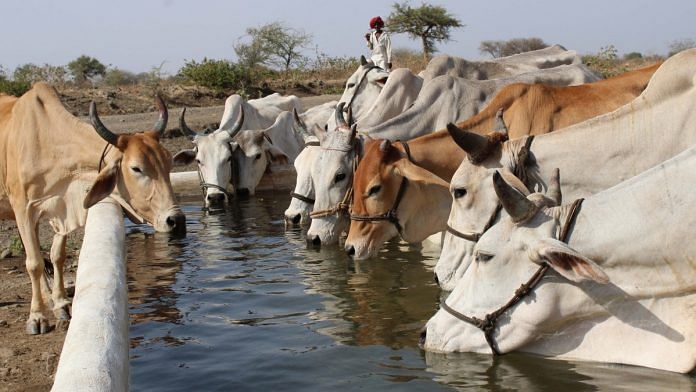
New Delhi: The Modi government’s cow commission has dropped 10 chapters from the “reference material” compiled for its nationwide ‘cow science’ exam after many of the claims made in the text were termed unscientific.
The controversial text — running into 54 pages, spanning 12 chapters — sought to link cow slaughter and earthquakes, and called Jersey cows (a foreign breed) lazy and prone to diseases.
ThePrint had broken the story about its controversial content — which also projected cow milk and urine, among other products, as treatment for skin conditions — on 6 January, the day it was uploaded on the Rashtriya Kamdhenu Aayog’s website.
The material was taken off the website two days later.
A fresh version was uploaded Monday, but it is one-third the original length and only includes two chapters.
Reached for comment, a media representative of the Aayog said they had removed the material to address some “technical glitches”, adding that the chapters will be “uploaded one by one” with links to “more authors and publishers”.
The Rashtriya Kamdhenu Aayog was set up in 2019 with a mandate that includes organising “animal husbandry on modern and scientific lines” and taking “steps for preserving and improving breeds”.
The reference material in question is supposed to guide those who take the Aayog’s ‘cow science exam’, which is scheduled for 25 February.
Two officials in the Union Animal Husbandry Department, under which the Aayog was set up, said the initiatives taken by the commission are not discussed with them. The affair, they added, had “humiliated” them.
The republished chapters
The two chapters uploaded Monday are revised versions of the earlier text.
In the title of one, the commission has changed the term “Kamdhenu Mata” to “Desi Cow”. It is now called “Desi cows and some shlokas in scriptures”.
The Aayog has also dropped two shlokas dealing with “administration and direction for cow grazing” and “other aspects of the cow”.
In the second chapter, “Indigenous cattle breeds of India”, the list has been updated with ‘Kasaragod gidda’ from Karnataka and Kerala.
The 10 chapters that have been dropped are: ‘The difference between Native (Desi) and Exotic cow’, ‘Panchgavya and its usefulness’, ‘Feeds, fodder and gauchar bhoomi’, ‘Ethnoveterinary formulation’, ‘Care and management of cow and calf’, ‘Cow – environment and climate change’, ‘Cow: an engine of progress and prosperity’, ‘About Rashtriya Kamdhenu Aayog’, ‘Which dignitary said what about cow’, and ‘Patent’.
The controversial chapters
In the chapter ‘The difference between Native and Exotic cow’, the commission listed 21 “distinct qualities” of the two. The text then sought to portray indigenous cows as being superior to the Jersey breed, which has its origins in the UK.
“Indian cows maintain hygiene, are hardy and clever enough to not sit in dirty places while Jersey cows are known to be very lazy and prone to diseases,” it said.
“Whenever an unknown person comes near a desi cow, she immediately stands while no emotions are displayed by the Jersey. Desi cow is very active in nature and shares warmth with all while the Jersey cow sits idle and very inactive,” it added.
In the chapter ‘Panchgavya and its usefulness’ — panchgavya comprises cow milk and its two derivatives, ghee and butter, apart from urine and dung — cow dung was described as an antiseptic with disease-preventive properties. Cow urine, meanwhile, was referred to as “a gift to mankind” and equated with Gangajal.
Another chapter quoted a theory by physicists M.M. Bajaj, Ibrahim and Vijayraj Singh that links animal slaughter to natural calamities like earthquakes.
“The theory examines the complex role of nociceptive waves (the waves generated by the animals on the verge of being butchered) in shear wave splitting which is related to seismic anisotropy,” it states.
Nociceptors are neurons that sense danger and alert the body. Seismic anisotropy is described as “the directional dependence of seismic velocity”.
The material also stated that cow protection and ox power could solve all the modern-world problems, such as air and water pollution, crime, poverty, unemployment, war, famine, floods, pestilence, and global warming.
The content came in for much criticism online.
The general direction where science is headed in India under Modi. Now a national exam on COW SCIENCE, and these are the purported good effects of drinking cow piss. Rationalism is more urgent than ever before. pic.twitter.com/vURX3m4Zqh
— dr. meena kandasamy || இளவேனில் (@meenakandasamy) January 6, 2021
According to a study guide for an exam on “cow science” in India, cows enhance a person’s aura and slaughtering the animals causes earthquakes. @mehta_gautama reports on the spread of bovine pseudoscience.https://t.co/xCbxK5y14t
— Coda Story (@CodaStory) January 14, 2021
Commission’s stand
The controversy kicked up by the Aayog upset top functionaries of the Animal Husbandry Department, ThePrint has learnt.
“You don’t have to promote indigenous cow breeds by demeaning the Jersey or other cow breeds,” said an official, not wishing to be named.
Another functionary added, “We got to know about this exam through newspapers and felt humiliated afterwards. The initiatives taken by the commission aren’t discussed with the animal husbandry department.”
Reached for comment, the spokesperson of the Kamdhenu Aayog told ThePrint that the “reference material was withdrawn due to some technical glitches”.
“We will be uploading the chapters one by one in the coming days linking more authors and publishers,” the spokesperson said, adding that the chapter on Panchgavya will be uploaded Wednesday.
Subscribe to our channels on YouTube & Telegram
Why news media is in crisis & How you can fix it
India needs free, fair, non-hyphenated and questioning journalism even more as it faces multiple crises.
But the news media is in a crisis of its own. There have been brutal layoffs and pay-cuts. The best of journalism is shrinking, yielding to crude prime-time spectacle.
ThePrint has the finest young reporters, columnists and editors working for it. Sustaining journalism of this quality needs smart and thinking people like you to pay for it. Whether you live in India or overseas, you can do it here.